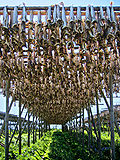Drying
Drying is a process by which moisture is removed from a material, typically to reduce its water content to a specific level. The process is widely used in various industries, including food preservation, pharmaceuticals, and manufacturing. Drying can be achieved through several methods, including air drying, freeze drying, spray drying, and oven drying, each with its specific applications and advantages.
Overview[edit]
Drying is a critical step in the preservation of many materials. By reducing the water content, the growth of microorganisms is inhibited, which in turn increases the shelf life of the product. In the pharmaceutical industry, drying is essential for the stability and bioavailability of certain drugs. In manufacturing, drying processes are crucial for the preparation of materials and the development of products with specific characteristics.
Methods of Drying[edit]
Air Drying[edit]
Air drying is one of the simplest and oldest methods of removing moisture. It involves exposing the material to air in a controlled environment. The rate of drying depends on the humidity and temperature of the air, as well as the surface area of the material.
Freeze Drying[edit]
Freeze drying, also known as lyophilization, involves freezing the material and then reducing the surrounding pressure to allow the frozen water in the material to sublimate directly from the solid phase to the gas phase. This method is particularly useful for preserving heat-sensitive materials such as proteins and pharmaceuticals.
Spray Drying[edit]
Spray drying involves atomizing the material into a fine mist and then drying it in a hot gas. This method is commonly used in the food and pharmaceutical industries to produce powders from a liquid feedstock.
Oven Drying[edit]
Oven drying uses heated air to remove moisture from materials. The temperature and duration of drying must be carefully controlled to prevent damage to the material.
Applications[edit]
Drying has a wide range of applications across various industries. In the food industry, drying is used to produce products like powdered milk, instant coffee, and dried fruits. In the pharmaceutical industry, drying processes are used to create stable and easy-to-store forms of medication. In the field of manufacturing, drying is essential in the production of materials such as ceramics, paints, and plastics.
Challenges[edit]
Despite its widespread use, drying presents several challenges. The process can be energy-intensive and costly, especially for methods like freeze drying. There is also the risk of altering the properties of the material being dried, such as its color, texture, and nutritional content. Therefore, selecting the appropriate drying method and optimizing the drying conditions are crucial to maintaining the quality of the product.
Conclusion[edit]
Drying is a fundamental process with critical applications in food preservation, pharmaceuticals, and manufacturing. While it offers significant benefits in terms of extending the shelf life and improving the stability of products, it also poses challenges that require careful consideration and management. As technology advances, new and more efficient drying techniques are likely to be developed, further expanding the applications and benefits of this essential process.
Ad. Transform your life with W8MD's Budget GLP-1 injections from $75


W8MD offers a medical weight loss program to lose weight in Philadelphia. Our physician-supervised medical weight loss provides:
- Weight loss injections in NYC (generic and brand names):
- Zepbound / Mounjaro, Wegovy / Ozempic, Saxenda
- Most insurances accepted or discounted self-pay rates. We will obtain insurance prior authorizations if needed.
- Generic GLP1 weight loss injections from $75 for the starting dose.
- Also offer prescription weight loss medications including Phentermine, Qsymia, Diethylpropion, Contrave etc.
NYC weight loss doctor appointmentsNYC weight loss doctor appointments
Start your NYC weight loss journey today at our NYC medical weight loss and Philadelphia medical weight loss clinics.
- Call 718-946-5500 to lose weight in NYC or for medical weight loss in Philadelphia 215-676-2334.
- Tags:NYC medical weight loss, Philadelphia lose weight Zepbound NYC, Budget GLP1 weight loss injections, Wegovy Philadelphia, Wegovy NYC, Philadelphia medical weight loss, Brookly weight loss and Wegovy NYC
|
WikiMD's Wellness Encyclopedia |
| Let Food Be Thy Medicine Medicine Thy Food - Hippocrates |
Medical Disclaimer: WikiMD is not a substitute for professional medical advice. The information on WikiMD is provided as an information resource only, may be incorrect, outdated or misleading, and is not to be used or relied on for any diagnostic or treatment purposes. Please consult your health care provider before making any healthcare decisions or for guidance about a specific medical condition. WikiMD expressly disclaims responsibility, and shall have no liability, for any damages, loss, injury, or liability whatsoever suffered as a result of your reliance on the information contained in this site. By visiting this site you agree to the foregoing terms and conditions, which may from time to time be changed or supplemented by WikiMD. If you do not agree to the foregoing terms and conditions, you should not enter or use this site. See full disclaimer.
Credits:Most images are courtesy of Wikimedia commons, and templates, categories Wikipedia, licensed under CC BY SA or similar.
Translate this page: - East Asian
中文,
日本,
한국어,
South Asian
हिन्दी,
தமிழ்,
తెలుగు,
Urdu,
ಕನ್ನಡ,
Southeast Asian
Indonesian,
Vietnamese,
Thai,
မြန်မာဘာသာ,
বাংলা
European
español,
Deutsch,
français,
Greek,
português do Brasil,
polski,
română,
русский,
Nederlands,
norsk,
svenska,
suomi,
Italian
Middle Eastern & African
عربى,
Turkish,
Persian,
Hebrew,
Afrikaans,
isiZulu,
Kiswahili,
Other
Bulgarian,
Hungarian,
Czech,
Swedish,
മലയാളം,
मराठी,
ਪੰਜਾਬੀ,
ગુજરાતી,
Portuguese,
Ukrainian





